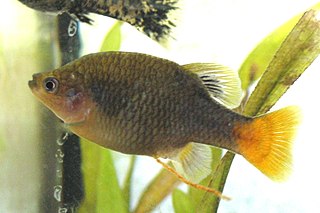
Goodeidae is a family of teleost fish endemic to Mexico and some areas of the United States. Many species are known as splitfins. This family contains about 50 species within 18 genera. The family is named after ichthyologist George Brown Goode (1851-1896).

Congiopodidae, commonly known as pigfishes, horsefishes and racehorses, is a family of ray-finned fish classified with in the order Scorpaeniformes. These fishes are native to the Southern Hemisphere.

Trichogaster is a genus of gouramis native to South Asia from Pakistan to Myanmar. It is the only genus in the monotypic subfamily Trichogastrinae as set out in the 5th Edition of Fishes of the World, although that book states that there are two genera, the other being Colisa which is treated as a synonym of Trichogaster by Fishbase and the Catalog of Fishes. Fishbase also places the genus in the Luciocephalinae. Species of this genus are very popular in the aquarium trade.

Stichaeidae, the pricklebacks or shannies, are a family of marine ray-finned fishes in the suborder Zoarcoidei of the order Scorpaeniformes. Most species are found in the North Pacific Ocean with a few in the North Atlantic Ocean.

Goodea is a genus of splitfins that are endemic to Mexico. They are found in a wide range of habitats in several river basins that originate in the Central Plateau, such as Pánuco, Lerma–Chapala–Grande de Santiago and Balsas. Overall this genus is among the most widespread and successful splitfins, although they also have declined and the relatively restricted G. gracilis is considered vulnerable by the IUCN. This genus includes the largests splitfins, reaching a standard length of up to 20 cm (8 in). They are primarily herbivores, but also take small organisms like tiny crustaceans and snails. The is named in honour of the American ichthyologist George Brown Goode (1851-1896).

The Highland splitfin is a species of splitfin endemic to Mexico where it is found in the Lerma River basin. This species grows to a length of 5 centimetres (2.0 in) TL. It is the only known member of its genus, although some authorities have Hubbina as a subgenus of Girardinichthys and add Girardinichthys ireneae to the subgenus, even treating this taxon as a synonym of G. ireneae. This species was described by Don Fernando de Buen y Lozano in 1940 with the type locality given as Cointzio, Michoacán. The name of the genus honours the American ichthyologist Carl Leavitt Hubbs (1894-1979) while the specific name honours Clarence Lester Turner (1890-1969), thus honouring two ichthyologists who worked on a review of the Goodeidae in 1939.

The Balsas splitfin is a species of fish in the family Goodeidae. It is endemic to Mexico where it occurs in the states of Morelos and Michoacán. This fish was formally described as Goodea whitei by Seth Eugene Meek in 1904 with the type locality given as Yautepec in Morelos. The specific name honours E. A. White of the Interoceanic Railway of Mexico for his interest in and support of Meek's work.

Zaniolepis, the combfishes, is a genus of marine ray-finned fish, it is one of two genera in the family Zaniolepididae. These fishes are native to the eastern Pacific Ocean. Z. frenata that was a source of food to the Native American inhabitants of San Nicolas Island off the coast of southern California, United States during the Middle Holocene.
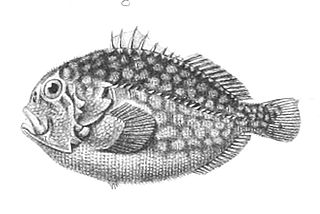
Caracanthus, the coral crouchers, or orbicular velvetfishes, are a genus of ray-finned fishes. They live in coral reefs of the tropical Indo-Pacific. This genus is the only member of the monotypic subfamily Caracanthinae, part of the family Scorpaenidae.

Fodiator is a genus of flying fishes. It is the only genus in the subfamily Fodiatorinae.
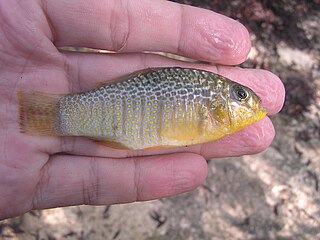
Floridichthys is a genus of pupfishes native to the southeastern United States, Mexico and northern Central America. The name of this genus is a compound of Florida and the Greek for "fish", ichthys. The ichthyologist Carl Leavitt Hubbs thought that the genus was confined to Florida at the time he coined the name.

Bothragonus is a genus of marine ray-finned fishes belonging to the family Agonidae, the poachers and related fishes. It is the only genus in monotypic subfamily Bothragoninae. These fishes are found in the northern Pacific Ocean.
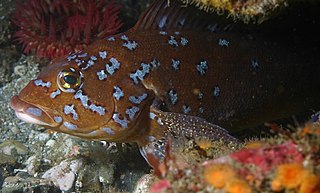
Hexagrammos is a genus of marine ray-finned fishes belonging to the family Hexagrammidae, the greenlings. These fishes are found in the north Pacific Ocean.

Parabembras is a genus of marine ray-finned fish belonging to the family Bembridae, the deepwater flatheads, although they are sufficiently different from the other genera in that family to be classified as their own family, Parabembradidae, by some authorities. These fishes are found in the Indian Ocean and the western Pacific Ocean.

Tlaloc is a genus of fish in the family Profundulidae endemic to Mexico, Guatemala and Honduras. The genus is not, however, recognised by Fishbase or in the 5th Edition of Fishes of the World. The genus is named for Tlaloc the water god of the Aztecs.

Milyeringidae, the blind cave gobies, is a small family of gobies, in the order Gobiiformes. There are two genera and six species within the family, which is considered to be a subfamily of the Eleotridae by some authorities. Milyeringidae includes one genus (Milyeringa) restricted to caves in the North West Cape region of Australia and the other (Typhleotris) to underground water systems in Madagascar. They are all troglobitic species and have lost their eyes.
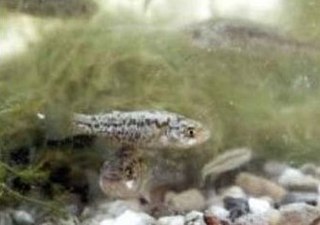
Empetrichthyinae is a subfamily of fishes, one of two subfamilies that make up the family Goodeidae.

Goodea luitpoldii, the green goodea, is a species of killifish from the family Goodeidae which is endemic to the drainage basin of the Lerma River and the Grande de Santiago River in Mexico. This species was Species description described as Characodon luitpoldii by the Franz Steindachner in 1894 with the type locality given as Lake Pátzcuaro in Michoacán. The identity of the person honoured in its specific name is unknown but it is thought likely to be Luitpold, Prince Regent of Bavaria (1821-1912) whose daughter, Princess Therese of Bavaria (1850-1925) was an explorer and amateur naturalist and she collected the type.
Gymnelinae is a subfamily of marine ray-finned fish belonging to the family Zoarcidae, the eelpouts. Most species are found in the North Pacific Ocean but one genus is cosmopolitan, and another is endemic to the Southern Ocean.
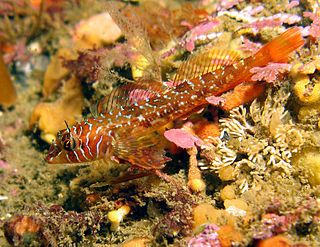
Jordaniidae is a small family of marine ray-finned fishes belonging to the order Scorpaeniformes. These fishes are found in the eastern North Pacific Ocean.



















